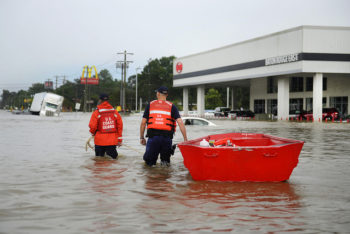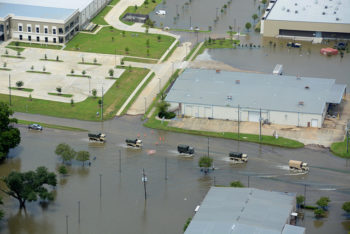New Flood Standards for the New Normal Flood
Can the Obama Administration’s new flood standard help communities better prepare for bigger, more frequent floods?
The Louisiana flooding has been described as “extreme”, “devastating”, “shocking” and the numbers certainly convey the gravity of the situation. 31.39 inches of rain fell in Watson, LA. River crest records were broken by up to 5 feet. 30,000 people were rescued. 60,000 homes damaged and the number keeps rising. Tragically, at least 13 people are dead. Scientists say the chances of a flood like this were at least one in 500.
As astounding as those numbers are, to me the most sobering fact is that this was the eighth 500-year rain event in the United States in just over a year, according to NOAA. Events in Texas, West Virginia, Maryland, and elsewhere have brought the reality of climate change into perspective.

Coast Guardsmen use a flat-bottom boat to assist residents during severe flooding around Baton Rouge, LA | Petty Officer 3rd Class Brandon Giles
On Tuesday President Obama visited Louisiana to take in the scope of the disaster and provide some hope to the people struggling to figure out how to rebuild their lives and homes. It’s clear that significant investments will be needed to make Louisianans whole and make their communities more resilient to the more frequent and extreme storm events we should expect from climate change impacts.
President Obama’s trip comes a day after his administration took an action that should give us all hope for how we recover from future floods. On Monday the Federal Emergency Management Administration (FEMA) released their proposed rule to update the federal flood standards that determine if and how the federal government invests in development in floodplains. The new standards will ensure that a greater margin of safety is used so that federally funded infrastructure can withstand larger floods. Not only will this reduce damage to infrastructure and keep communities safe, it also helps protect river health by encouraging development to occur on safer, higher ground.

Louisiana Army National Guard vehicles transport flood relief supplies | 1st Sgt. Paul Meeker
The standard will also help rivers and improve public safety by requiring consideration of natural approaches that use floodplains to safely convey and buffer the impacts of floods. Natural flood management approaches like floodplain restoration result in less infrastructure at risk of flood damage and support an array of benefits to rivers and riverine communities including wildlife and fish habitat, clean water, and recharged groundwater supplies.
These changes are the result of lessons learned after past flooding disasters in Louisiana, Colorado, the Northeast, and across the country. They were identified as necessary to the safety of the nation in the President’s Climate Action Plan, the Sandy Task Force Rebuilding Strategy, and Recommendations of the President’s State, Local, and Tribal Task Force for Climate Preparedness.
FEMA is taking comments on their new standard until October 21. There is still work to be done to implement it and other agencies are expected to unveil their own implementation plans in the coming months. In the meantime, we hope the state of Louisiana will utilize the lessons learned from past floods, and the administration will help affected communities rebuild resiliently as quickly as possible.



